ERM Strategies and Implementation: LEGO Group and Higher Ed
VerifiedAdded on 2022/10/31
|7
|1182
|452
Report
AI Summary
This report provides a critical examination of Enterprise Risk Management (ERM) initiatives undertaken by the LEGO Group, focusing on its strategies for expansion in European markets. It outlines the organization's approach to risk management, categorizing risks into operational, financial, hazardous, and miscellaneous types, with a primary emphasis on mitigating financial risks. The report contrasts the ERM implementation in profit-making organizations like LEGO with that in higher education institutions, highlighting differences in governance structures and cultures. It analyzes the impact of ERM on organizational efficiency and the adoption of a centralized structure to improve implementation and review processes. The report also includes an annotated bibliography of key research papers, such as those by Viscelli, Beasley, & Hermanson (2016), exploring the role of ERM in risk governance and the importance of internal audits in supporting ERM practices. Additionally, the report references other relevant studies by Agustina & Baroroh (2016), and Sum & Saad (2017) to provide a comprehensive overview of the subject matter.
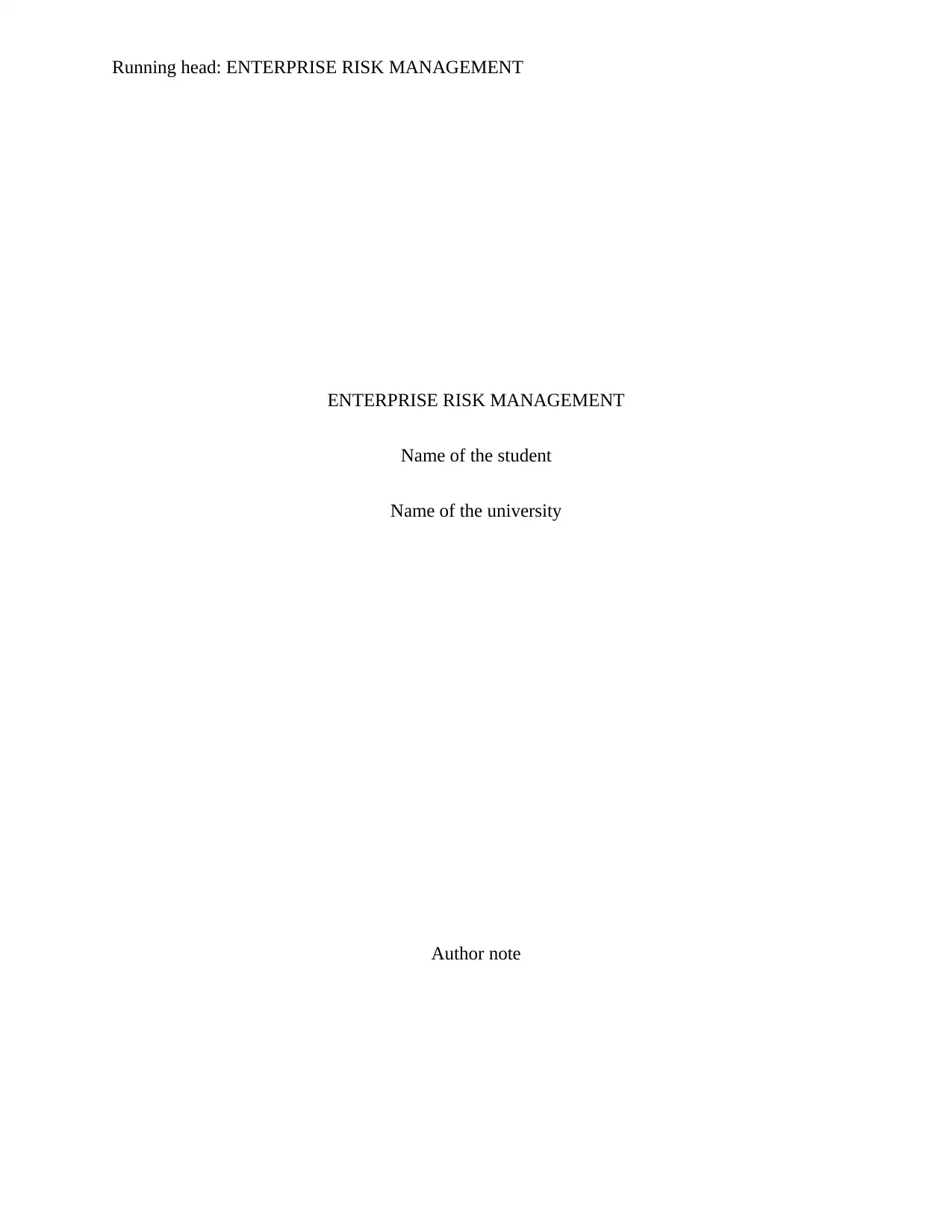
Running head: ENTERPRISE RISK MANAGEMENT
ENTERPRISE RISK MANAGEMENT
Name of the student
Name of the university
Author note
ENTERPRISE RISK MANAGEMENT
Name of the student
Name of the university
Author note
Paraphrase This Document
Need a fresh take? Get an instant paraphrase of this document with our AI Paraphraser
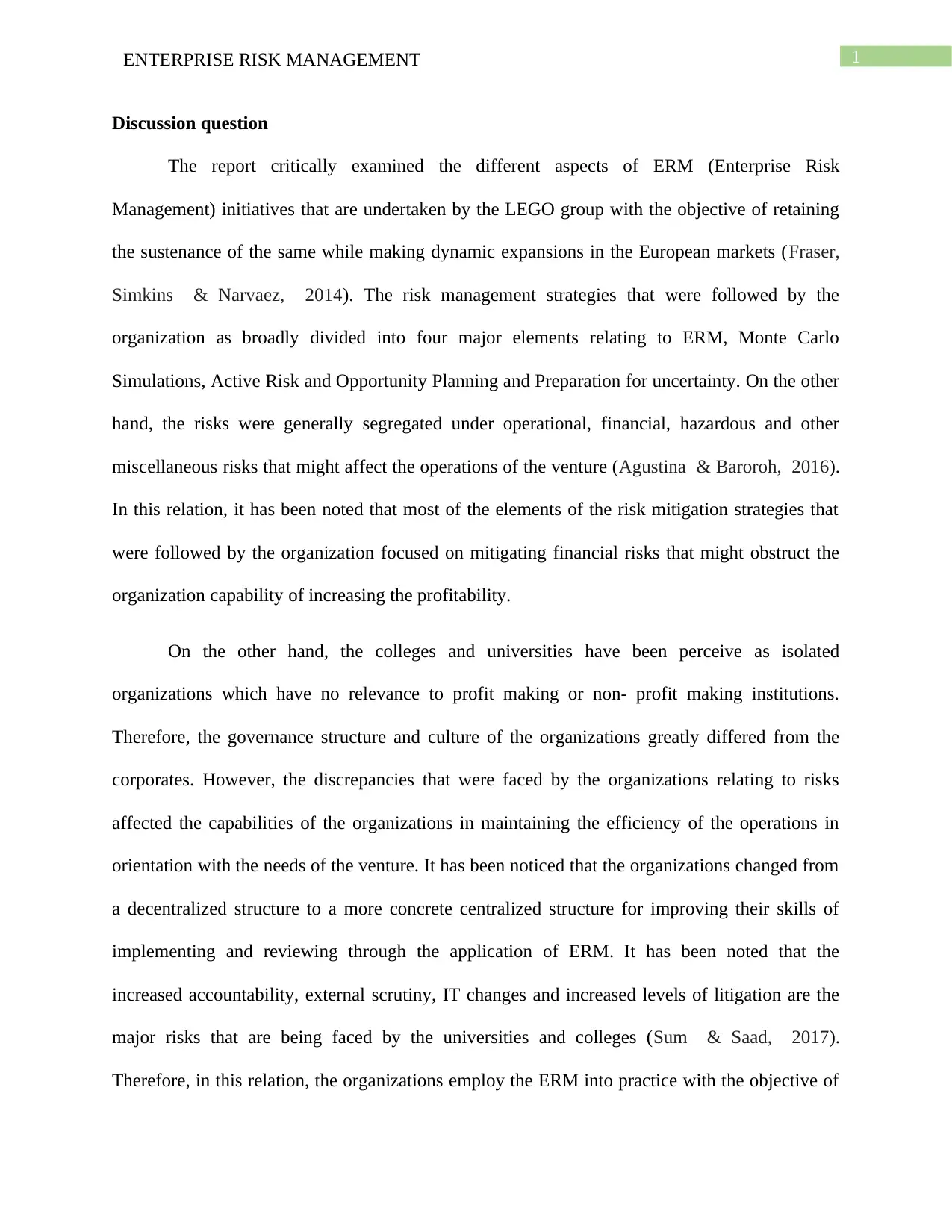
1ENTERPRISE RISK MANAGEMENT
Discussion question
The report critically examined the different aspects of ERM (Enterprise Risk
Management) initiatives that are undertaken by the LEGO group with the objective of retaining
the sustenance of the same while making dynamic expansions in the European markets (Fraser,
Simkins & Narvaez, 2014). The risk management strategies that were followed by the
organization as broadly divided into four major elements relating to ERM, Monte Carlo
Simulations, Active Risk and Opportunity Planning and Preparation for uncertainty. On the other
hand, the risks were generally segregated under operational, financial, hazardous and other
miscellaneous risks that might affect the operations of the venture (Agustina & Baroroh, 2016).
In this relation, it has been noted that most of the elements of the risk mitigation strategies that
were followed by the organization focused on mitigating financial risks that might obstruct the
organization capability of increasing the profitability.
On the other hand, the colleges and universities have been perceive as isolated
organizations which have no relevance to profit making or non- profit making institutions.
Therefore, the governance structure and culture of the organizations greatly differed from the
corporates. However, the discrepancies that were faced by the organizations relating to risks
affected the capabilities of the organizations in maintaining the efficiency of the operations in
orientation with the needs of the venture. It has been noticed that the organizations changed from
a decentralized structure to a more concrete centralized structure for improving their skills of
implementing and reviewing through the application of ERM. It has been noted that the
increased accountability, external scrutiny, IT changes and increased levels of litigation are the
major risks that are being faced by the universities and colleges (Sum & Saad, 2017).
Therefore, in this relation, the organizations employ the ERM into practice with the objective of
Discussion question
The report critically examined the different aspects of ERM (Enterprise Risk
Management) initiatives that are undertaken by the LEGO group with the objective of retaining
the sustenance of the same while making dynamic expansions in the European markets (Fraser,
Simkins & Narvaez, 2014). The risk management strategies that were followed by the
organization as broadly divided into four major elements relating to ERM, Monte Carlo
Simulations, Active Risk and Opportunity Planning and Preparation for uncertainty. On the other
hand, the risks were generally segregated under operational, financial, hazardous and other
miscellaneous risks that might affect the operations of the venture (Agustina & Baroroh, 2016).
In this relation, it has been noted that most of the elements of the risk mitigation strategies that
were followed by the organization focused on mitigating financial risks that might obstruct the
organization capability of increasing the profitability.
On the other hand, the colleges and universities have been perceive as isolated
organizations which have no relevance to profit making or non- profit making institutions.
Therefore, the governance structure and culture of the organizations greatly differed from the
corporates. However, the discrepancies that were faced by the organizations relating to risks
affected the capabilities of the organizations in maintaining the efficiency of the operations in
orientation with the needs of the venture. It has been noticed that the organizations changed from
a decentralized structure to a more concrete centralized structure for improving their skills of
implementing and reviewing through the application of ERM. It has been noted that the
increased accountability, external scrutiny, IT changes and increased levels of litigation are the
major risks that are being faced by the universities and colleges (Sum & Saad, 2017).
Therefore, in this relation, the organizations employ the ERM into practice with the objective of
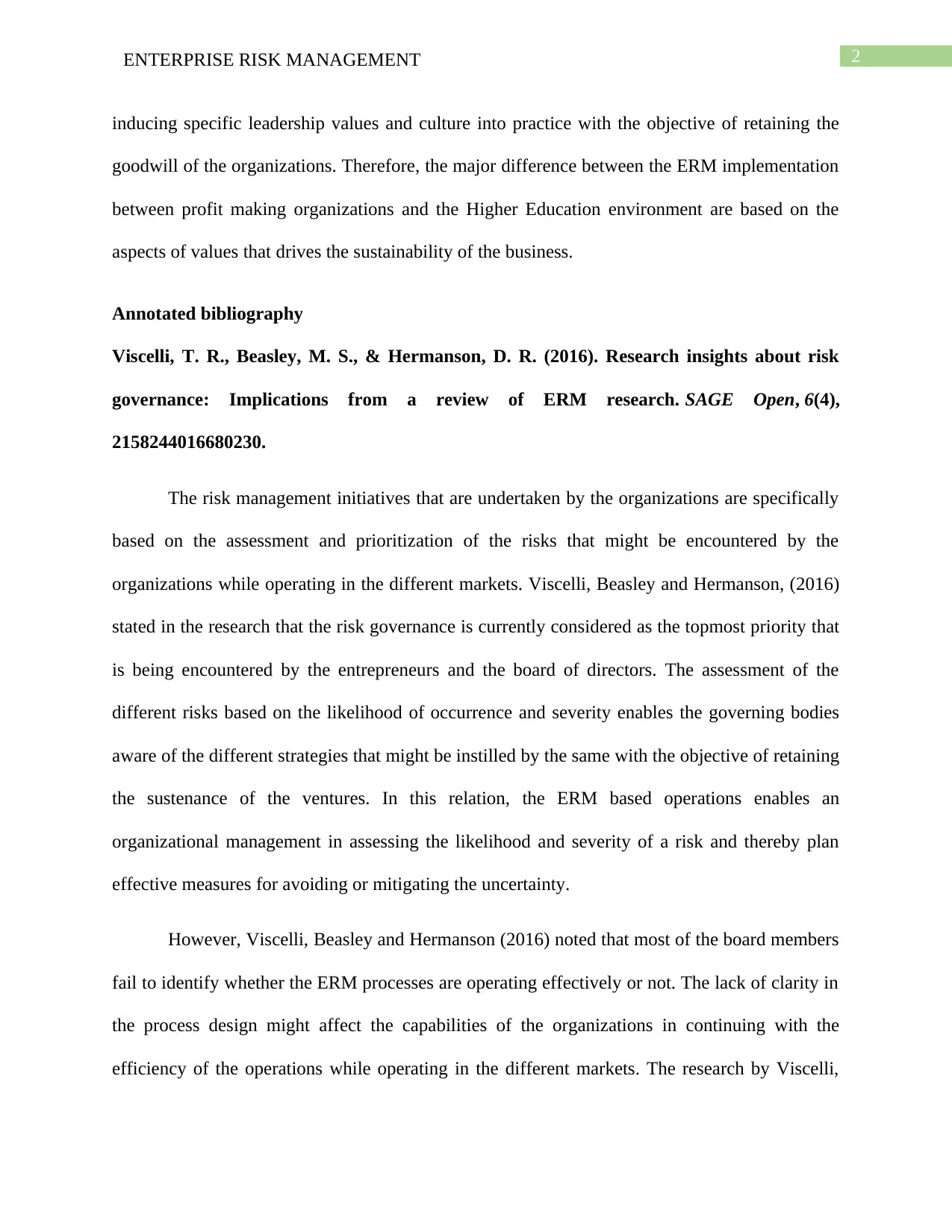
2ENTERPRISE RISK MANAGEMENT
inducing specific leadership values and culture into practice with the objective of retaining the
goodwill of the organizations. Therefore, the major difference between the ERM implementation
between profit making organizations and the Higher Education environment are based on the
aspects of values that drives the sustainability of the business.
Annotated bibliography
Viscelli, T. R., Beasley, M. S., & Hermanson, D. R. (2016). Research insights about risk
governance: Implications from a review of ERM research. SAGE Open, 6(4),
2158244016680230.
The risk management initiatives that are undertaken by the organizations are specifically
based on the assessment and prioritization of the risks that might be encountered by the
organizations while operating in the different markets. Viscelli, Beasley and Hermanson, (2016)
stated in the research that the risk governance is currently considered as the topmost priority that
is being encountered by the entrepreneurs and the board of directors. The assessment of the
different risks based on the likelihood of occurrence and severity enables the governing bodies
aware of the different strategies that might be instilled by the same with the objective of retaining
the sustenance of the ventures. In this relation, the ERM based operations enables an
organizational management in assessing the likelihood and severity of a risk and thereby plan
effective measures for avoiding or mitigating the uncertainty.
However, Viscelli, Beasley and Hermanson (2016) noted that most of the board members
fail to identify whether the ERM processes are operating effectively or not. The lack of clarity in
the process design might affect the capabilities of the organizations in continuing with the
efficiency of the operations while operating in the different markets. The research by Viscelli,
inducing specific leadership values and culture into practice with the objective of retaining the
goodwill of the organizations. Therefore, the major difference between the ERM implementation
between profit making organizations and the Higher Education environment are based on the
aspects of values that drives the sustainability of the business.
Annotated bibliography
Viscelli, T. R., Beasley, M. S., & Hermanson, D. R. (2016). Research insights about risk
governance: Implications from a review of ERM research. SAGE Open, 6(4),
2158244016680230.
The risk management initiatives that are undertaken by the organizations are specifically
based on the assessment and prioritization of the risks that might be encountered by the
organizations while operating in the different markets. Viscelli, Beasley and Hermanson, (2016)
stated in the research that the risk governance is currently considered as the topmost priority that
is being encountered by the entrepreneurs and the board of directors. The assessment of the
different risks based on the likelihood of occurrence and severity enables the governing bodies
aware of the different strategies that might be instilled by the same with the objective of retaining
the sustenance of the ventures. In this relation, the ERM based operations enables an
organizational management in assessing the likelihood and severity of a risk and thereby plan
effective measures for avoiding or mitigating the uncertainty.
However, Viscelli, Beasley and Hermanson (2016) noted that most of the board members
fail to identify whether the ERM processes are operating effectively or not. The lack of clarity in
the process design might affect the capabilities of the organizations in continuing with the
efficiency of the operations while operating in the different markets. The research by Viscelli,
⊘ This is a preview!⊘
Do you want full access?
Subscribe today to unlock all pages.

Trusted by 1+ million students worldwide
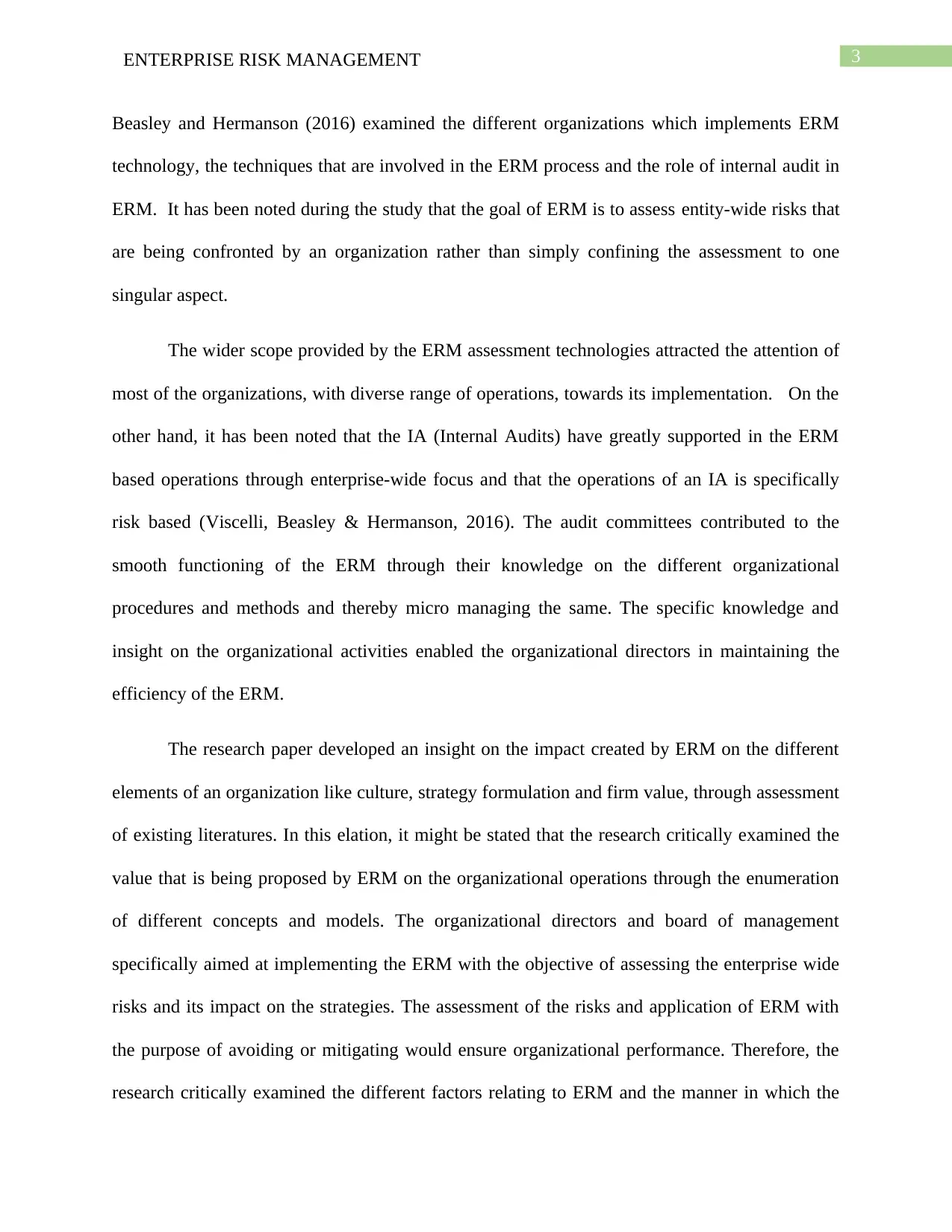
3ENTERPRISE RISK MANAGEMENT
Beasley and Hermanson (2016) examined the different organizations which implements ERM
technology, the techniques that are involved in the ERM process and the role of internal audit in
ERM. It has been noted during the study that the goal of ERM is to assess entity-wide risks that
are being confronted by an organization rather than simply confining the assessment to one
singular aspect.
The wider scope provided by the ERM assessment technologies attracted the attention of
most of the organizations, with diverse range of operations, towards its implementation. On the
other hand, it has been noted that the IA (Internal Audits) have greatly supported in the ERM
based operations through enterprise-wide focus and that the operations of an IA is specifically
risk based (Viscelli, Beasley & Hermanson, 2016). The audit committees contributed to the
smooth functioning of the ERM through their knowledge on the different organizational
procedures and methods and thereby micro managing the same. The specific knowledge and
insight on the organizational activities enabled the organizational directors in maintaining the
efficiency of the ERM.
The research paper developed an insight on the impact created by ERM on the different
elements of an organization like culture, strategy formulation and firm value, through assessment
of existing literatures. In this elation, it might be stated that the research critically examined the
value that is being proposed by ERM on the organizational operations through the enumeration
of different concepts and models. The organizational directors and board of management
specifically aimed at implementing the ERM with the objective of assessing the enterprise wide
risks and its impact on the strategies. The assessment of the risks and application of ERM with
the purpose of avoiding or mitigating would ensure organizational performance. Therefore, the
research critically examined the different factors relating to ERM and the manner in which the
Beasley and Hermanson (2016) examined the different organizations which implements ERM
technology, the techniques that are involved in the ERM process and the role of internal audit in
ERM. It has been noted during the study that the goal of ERM is to assess entity-wide risks that
are being confronted by an organization rather than simply confining the assessment to one
singular aspect.
The wider scope provided by the ERM assessment technologies attracted the attention of
most of the organizations, with diverse range of operations, towards its implementation. On the
other hand, it has been noted that the IA (Internal Audits) have greatly supported in the ERM
based operations through enterprise-wide focus and that the operations of an IA is specifically
risk based (Viscelli, Beasley & Hermanson, 2016). The audit committees contributed to the
smooth functioning of the ERM through their knowledge on the different organizational
procedures and methods and thereby micro managing the same. The specific knowledge and
insight on the organizational activities enabled the organizational directors in maintaining the
efficiency of the ERM.
The research paper developed an insight on the impact created by ERM on the different
elements of an organization like culture, strategy formulation and firm value, through assessment
of existing literatures. In this elation, it might be stated that the research critically examined the
value that is being proposed by ERM on the organizational operations through the enumeration
of different concepts and models. The organizational directors and board of management
specifically aimed at implementing the ERM with the objective of assessing the enterprise wide
risks and its impact on the strategies. The assessment of the risks and application of ERM with
the purpose of avoiding or mitigating would ensure organizational performance. Therefore, the
research critically examined the different factors relating to ERM and the manner in which the
Paraphrase This Document
Need a fresh take? Get an instant paraphrase of this document with our AI Paraphraser

4ENTERPRISE RISK MANAGEMENT
same is being applied in the business models. On the other hands, the research also examined he
role of Internal Audits in sustaining the ERM practices in firms.
same is being applied in the business models. On the other hands, the research also examined he
role of Internal Audits in sustaining the ERM practices in firms.
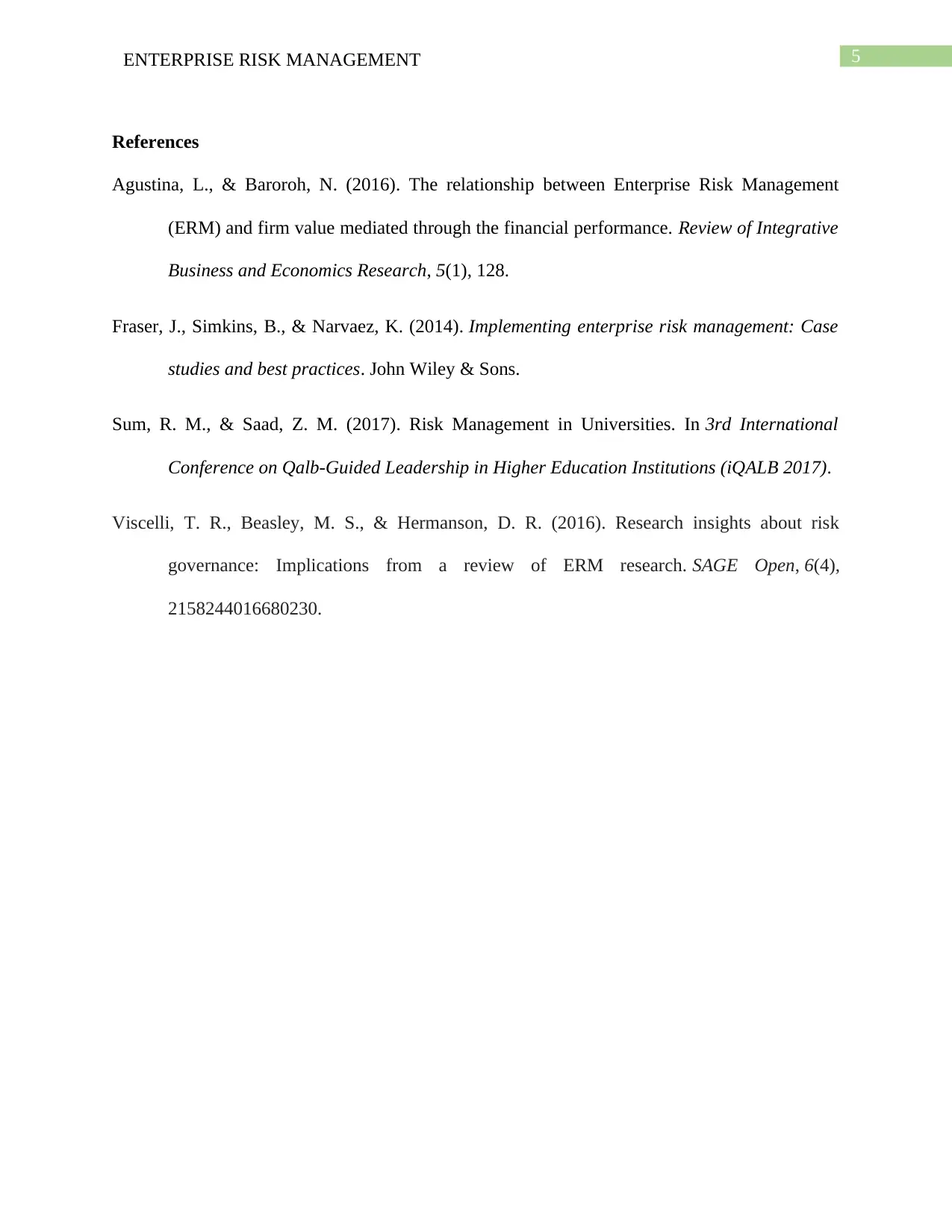
5ENTERPRISE RISK MANAGEMENT
References
Agustina, L., & Baroroh, N. (2016). The relationship between Enterprise Risk Management
(ERM) and firm value mediated through the financial performance. Review of Integrative
Business and Economics Research, 5(1), 128.
Fraser, J., Simkins, B., & Narvaez, K. (2014). Implementing enterprise risk management: Case
studies and best practices. John Wiley & Sons.
Sum, R. M., & Saad, Z. M. (2017). Risk Management in Universities. In 3rd International
Conference on Qalb-Guided Leadership in Higher Education Institutions (iQALB 2017).
Viscelli, T. R., Beasley, M. S., & Hermanson, D. R. (2016). Research insights about risk
governance: Implications from a review of ERM research. SAGE Open, 6(4),
2158244016680230.
References
Agustina, L., & Baroroh, N. (2016). The relationship between Enterprise Risk Management
(ERM) and firm value mediated through the financial performance. Review of Integrative
Business and Economics Research, 5(1), 128.
Fraser, J., Simkins, B., & Narvaez, K. (2014). Implementing enterprise risk management: Case
studies and best practices. John Wiley & Sons.
Sum, R. M., & Saad, Z. M. (2017). Risk Management in Universities. In 3rd International
Conference on Qalb-Guided Leadership in Higher Education Institutions (iQALB 2017).
Viscelli, T. R., Beasley, M. S., & Hermanson, D. R. (2016). Research insights about risk
governance: Implications from a review of ERM research. SAGE Open, 6(4),
2158244016680230.
⊘ This is a preview!⊘
Do you want full access?
Subscribe today to unlock all pages.

Trusted by 1+ million students worldwide

6ENTERPRISE RISK MANAGEMENT
1 out of 7
Related Documents
Your All-in-One AI-Powered Toolkit for Academic Success.
+13062052269
info@desklib.com
Available 24*7 on WhatsApp / Email
![[object Object]](/_next/static/media/star-bottom.7253800d.svg)
Unlock your academic potential
Copyright © 2020–2025 A2Z Services. All Rights Reserved. Developed and managed by ZUCOL.




